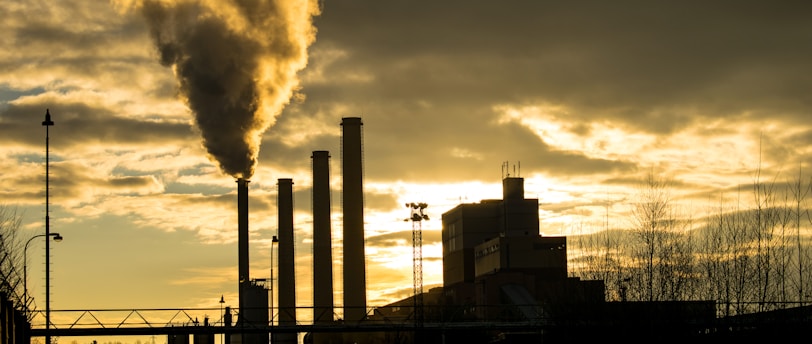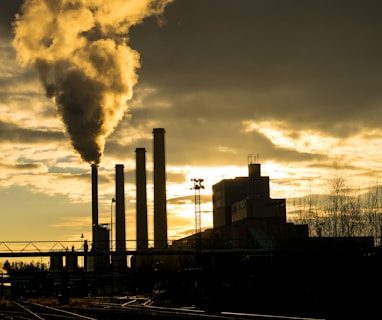The History of the Effects of Industrialization on Climate and Earth
The Industrial Revolution has had a profound impact on climate and earth. Learn about the history of the effects of industrialization on climate, earth, and what we can do to mitigate climate change.
4 min read


How Industrialization Has Impacted Climate and Earth
The Industrial Revolution, which began in the 18th century, was a period of rapid economic and social change. This change was driven by the use of new technologies, such as the steam engine, which led to the development of new industries, such as the textile industry.
The burning of fossil fuels, such as coal, to power these new industries released greenhouse gases into the atmosphere. These greenhouse gases trap heat, which causes the planet to warm. This warming is known as climate change.
The effects of climate change are already being felt around the world. These effects include:
Rising sea levels, which are threatening coastal communities
More extreme weather events, such as heat waves, droughts, floods, and wildfires
Changes in precipitation patterns, which are affecting agriculture and water resources
Melting glaciers and ice sheets, which are raising sea levels and disrupting ocean currents
The effects of climate change are likely to become more severe in the future. This is because the concentration of greenhouse gases in the atmosphere is continuing to increase.
Timeline of the Effects of Industrialization on Climate and Earth
1750: The Industrial Revolution begins in Great Britain.
1850: The average global temperature begins to rise.
1900: The concentration of carbon dioxide in the atmosphere reaches 280 parts per million (ppm).
1950: The average global temperature reaches 1 degree Celsius above pre-industrial levels.
1990: The concentration of carbon dioxide in the atmosphere reaches 350 ppm.
2015: The average global temperature reaches 1.2 degrees Celsius above pre-industrial levels.
2020: The concentration of carbon dioxide in the atmosphere reaches 415 ppm.
History of the Effects of Industrialization on Climate and Earth
The effects of industrialization on climate and earth have been well-documented by scientists. In 1824, Joseph Fourier theorised that the atmosphere acts like a greenhouse, trapping heat from the sun. In 1856, Eunice Foote demonstrated that carbon dioxide is a greenhouse gas.
In the early 20th century, scientists began to measure the concentration of greenhouse gases in the atmosphere. They found that the concentration of carbon dioxide was increasing, and that this increase was likely due to human activities, such as the burning of fossil fuels.
In the 1950s, the Intergovernmental Panel on Climate Change (IPCC) was established to assess the scientific evidence on climate change. The IPCC has concluded that climate change is real, that it is caused by human activities, and that it is already having a significant impact on the planet.
The effects of climate change are likely to become more severe in the future. This is because the concentration of greenhouse gases in the atmosphere is continuing to increase. If we do not take action to reduce greenhouse gas emissions, the effects of climate change could be catastrophic.
What Can We Do to Mitigate Climate Change?
There are a number of things that we can do to mitigate climate change. These include:
Investing in renewable energy sources, such as solar and wind power
Increasing energy efficiency
Switching to cleaner transportation fuels
Protecting forests
Reducing our consumption of meat
Changing our lifestyles to be more sustainable
By taking these steps, we can help to reduce the amount of greenhouse gases in the atmosphere and mitigate the effects of climate change.
Green Goods Guide
There are a number of green goods that consumers can buy to help reduce their environmental impact. These include:
Energy-efficient appliances
LED light bulbs
Electric vehicles
Sustainable clothing
Organic food
By buying these products, we can help to reduce the demand for fossil fuels and other unsustainable products.
Conclusion
Industrialization has had a profound impact on climate and earth. The good news is that there are a number of things that we can do to reduce our environmental impact and mitigate the effects of climate change. By making changes to our lifestyles, investing in renewable energy, and supporting sustainable businesses, we can help to create a more sustainable future for our planet.
Meta Title: The History of the Effects of Industrialization on Climate and Earth
Meta Description: The Industrial Revolution has had a profound impact on climate and earth. Learn about the history of the effects of industrialization on climate, earth, and what we can do to mitigate climate change.
Keywords:
industrialization and climate change
history of climate change
green goods
sustainable lifestyle
climate change mitigation
effects of industrialization on earth
climate change and the future
how to mitigate climate change
what can we do about climate change
sustainable businesses
renewable energy
energy efficiency
cleaner transportation fuels
The Future of Industrialization and Climate Change
The future of industrialization and climate change is uncertain. On the one hand, the continued burning of fossil fuels is likely to lead to further warming of the planet, with all the associated consequences. On the other hand, there is a growing movement towards a more sustainable future, based on renewable energy and other clean technologies.
The outcome of this battle will depend on a number of factors, including the pace of technological innovation, the willingness of governments to take action, and the choices that individuals make about their lifestyles.
If we are to avoid the worst effects of climate change, we need to make a significant shift away from fossil fuels and towards a more sustainable future. This will require a concerted effort from governments, businesses, and individuals.
We need to invest in renewable energy sources, such as solar and wind power. We need to make our homes and businesses more energy-efficient. We need to switch to cleaner transportation fuels. And we need to change our lifestyles to be more sustainable.
The future of industrialization and climate change is in our hands. If we act now, we can create a more sustainable future for our planet. But if we wait, it may be too late.
Conclusion
Industrialization has had a profound impact on climate and earth. The good news is that there are a number of things that we can do to reduce our environmental impact and mitigate the effects of climate change. By making changes to our lifestyles, investing in renewable energy, and supporting sustainable businesses, we can help to create a more sustainable future for our planet.
The future of industrialization and climate change is uncertain, but it is in our hands. If we act now, we can create a more sustainable future for our planet. But if we wait, it may be too late.
Call to Action
What can you do to help mitigate climate change? Here are a few ideas:
Reduce your energy consumption.
Switch to renewable energy sources.
Drive less and walk, bike, or take public transportation more.
Eat less meat.
Recycle and compost.
Support sustainable businesses.
Get involved in your community.
Every little bit helps. By making changes to our own lives, we can help to create a more sustainable future for our planet.
